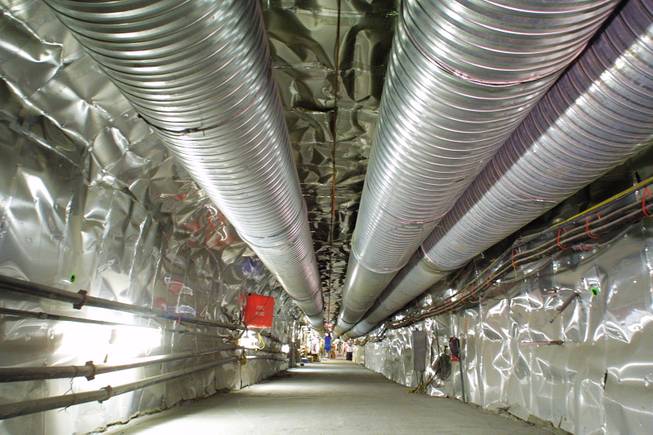
Las Vegas Sun
This is a tunnel seen during a public open house of Yucca Mountain on Saturday, Nov. 3, 2001.
Monday, June 24, 2019 | 2 a.m.
View more of the Sun's opinion section
When a train derailed Wednesday near the small town of Wells in northeast Nevada, it set off a scare as authorities reported that it was carrying military explosives and investigated whether it contained hazardous materials and reported that cars containing military explosives were within close proximity to the accident site. Officials shut down Interstate 80 as a plume of white powdery substance wafted from one of the cars.
Now, imagine how that scenario could play out if the Yucca Mountain nuclear waste project were ever built.
Instead of occurring in a remote part of the state near a community of about 1,300, the derailment could happen on a transportation route that would take it directly through the heart of Las Vegas.
And talk about hazardous: The stuff that would be going to Yucca is so potent that if unshielded, it would deliver a fatal dose of radioactivity within 70 seconds to someone standing near it.
That being the case, an accident involving that waste in Las Vegas wouldn’t result in just an interstate closure. Depending on the extent of the damage, it could leave untold numbers of people dead and could have catastrophic long-term effects on our community.
This is one of the many reasons why Yucca Mountain is a red-alert danger to Nevada.
Although proponents of the horrendous project love to claim that technology is in place to safely transport and store the waste, it’s the height of arrogance to think that human beings can engineer accident-proof transportation casks or design a facility that can contain the waste for the thousands of years that it would remain radioactive.
Farther from home, on Runit Island in the Pacific Ocean, lies another example of that arrogance. There, a containment facility for waste from the Cold War-era nuclear bomb tests in the Marshall Islands is leaking radioactive material into the ocean and is in danger of being ripped open in a powerful storm.
That “nuclear coffin,” as it’s known, is an 18-inch-thick concrete dome built over the crater from one of the bomb tests. The crater contains 73,000 cubic meters of radioactive soil that was collected from the tests across the various islands.
Like Yucca, the site was designed to safely store the material. And look how that worked out.
Granted, the Runit Island facility was supposed to be temporary, and therefore wasn’t built with an impermeable lining to prevent material from leaking.
But even if it had been, the concrete dome has cracked to the point that officials are concerned it could come apart in high winds and torrential rain.
The bottom line is that with the coffin, human designs and construction proved to be no match for time and nature. It would be exactly the same for Yucca.
The Nuclear Regulatory Commission’s own analysis acknowledges design flaws that would cause radioactive waste to leak into the water table and into the air through fissures in the rock. Due to seismic activity in the area, that’s not a matter of if, but when. The question is how much material would escape, and how extensive the damage would be.
Meanwhile, the potential transportation hazards loom well beyond Las Vegas and Nevada. As much as 110,000 metric tons of waste would be hauled by truck and train to the site along thousands of miles of roads that criss-cross through 329 congressional districts nationwide. An accident or terrorist attack anywhere along that massive network of roads and rails could be catastrophic.
Yet none of that is stopping Yucca proponents in Congress from continuing to press for funding to restart the project’s licensing process and start dumping waste down Nevada’s throat.
Lucky for us, Nevada’s congressional and state leaders are in lockstep in opposition to the site. Gov. Steve Sisolak has vowed that not a single ounce of waste will be transported to the state on his watch, a commitment shared by Sens. Catherine Cortez Masto and Jacky Rosen and U.S. Reps. Dina Titus, Susie Lee and Steven Horsford. Rep. Mark Amodei of Northern Nevada is the only congressional leader who’s not a “hell no” on the issue, having said he was open to discussion about it. But he’s also on record as being against unprocessed waste being transported to Nevada.
His colleagues have it right, though. Our door must remain firmly closed — welded shut, actually — to this nightmare in the making.
After the train accident in Wells, the scare blew over when it was determined that there was no hazardous material involved and that cars containing explosives weren’t among those that went off the tracks. The interstate was reopened after 50 minutes, and things quickly returned to normal.
If Yucca Mountain were opened, Las Vegas could only hope and pray that a rail accident involving highly radioactive waste would never occur here. If it did, think of the potential consequences: deaths, injuries, relocations and devastation of our economy as tourists and conventions found other locations.
Safe for thousands of years? Don’t count on it. It’s pure hubris and a sucker bet for Nevada.
